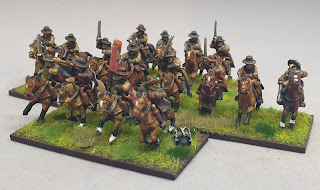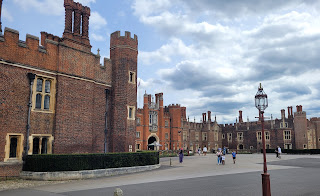Prince Maurice's Regiment of Horse
Another stalwart regiment of King's 'cavaliers'.
An extensive roll call of battles bookending the First Civil War: Powick Bridge; Edgehill; the storm of Cirencester; taking of Evesham; skirmish at Little Dean; skirmish at Upton Bridge; Ripple Field; Caversham Bridge; skirmish at Chewton Mendip; skirmish at Glastonbury and Somerton; skirmish at Bradford on Avon; Lansdown; Roundway Down; storm of Bristol; siege of Barnstaple; siege of Exeter; First Newbury; siege of Plymouth; Cheriton; Tipton Green; Cropredy Bridge; Lostwithiel; Second Newbury; the relief of Donnington; the relief of Chester; the relief of Beeston Castle; stormed Evesham; storm of Leicester; Naseby; storm of Huntingdon; Rowton Heath; skirmish at Tutbury; finishing the First Civil War at Stow on the Wold. Pretty much only Marston Moor missing from the First Civil War Greatest Hits album...
Maurice was of course Rupert's younger brother; aged sixteen, Maurice's military career began in the Prince of Orange's army. He was commended for his courage at the siege of Breda in 1637. By 1640, his allegiance had changed and he served in the Swedish army.
Maurice was given his first independent command in 1643 when he led an army of 2,000 men on the Welsh borders disrupting and harassing Waller's Southern Association army. He also handed Waller his first defeat at Ripple Field. His men joined the King's Western Army, where Maurice took command of the horse. Hopton was dismayed to find that Maurice did little to prevent his unruly cavaliers from plundering and looting.King Charles sent the royal physician William Harvey to attend Maurice. Charles also attempted to arrange a marriage to a rich French heiress in the hope of gaining further funds for the Royalist cause. Despite his uncle's pleas, however, Maurice remained unmarried. Both Maurice and his brother surrendered at Oxford in June 1646 and were banished from England by order of Parliament.
Maurice joined Prince Rupert and the future Charles II aboard a fleet of warships that had defected to the Royalists. In 1649, the brothers waged a war against Commonwealth shipping from a base in southern Ireland until their squadron was chased by Robert Blake from the Irish Sea to the Mediterranean. When Blake drove the brothers from the Mediterranean, they sailed to West Africa where Maurice raised his flag as Rupert's vice-admiral in a captured English ship, renamed the Defiance. With only four ships remaining they resumed their privateering activities in the West Indies in 1652.
Maurice was lost at sea during a storm near the Virgin Islands in September 1652. His loss deeply affected Rupert who for many years believed a rumour that Maurice had survived and was a prisoner of the Spaniards.













Lovely regiment of horse!
ReplyDeleteThanks Dean
DeleteAnother wonderful regiment The brothers are my favourite characters from the civil wars. Very much the image of cavaliers.
ReplyDeleteThanks Codsticker. I've ruminated before about Waller and Hopton being the basis of a good film script. Rupert and Maurice would too - a shoe in for buckles being swashed!
DeleteVery nicely done. One of my favourite regiments alongside his brother Rupert. Just out of left field where do you purchase the flags and for your lovely pikemen what length are the pikes. I understand you cut these down.
ReplyDeleteKeep up the grand work.
Cheers!
Thanks Knightly. All flags are Maverick Models fabric flags (without texture). I have gone for the texture 'design' on some of my mostly white flags.
DeletePikes? They are Donnington EQ10 pikes which were cut down to 52mm. Oversized I know - originally I wasn't sure how they would look (with the manufactured leaf point) so worked on the notion I could cut them down if I didn't like them. I did like the leaf point, and also think that the exaggerated pike length helps give a look of Streeter's Naseby Plan.
Donnington EQ10 pack has undergone a number of changes in the last couple of years. Latest incarnation is 50mm length
DeleteThank you Radar for your reply, sounds excellent.
DeleteCheers!